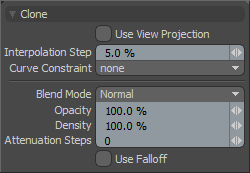The Clone tool provides a function to duplicate an area of a texture to another area. Useful for quickly covering imperfection is a photographic image by sampling from another like area of the image or for simply enlarging areas of useful texture. Before applying a stroke, you must define a clone source area. This can be done by holding the Ctrl key and clicking the area of the image where the center of the cloning originates from. Each stroke now clones from that center source until a new source is defined.
You can select the tool from the Paint interface tab under the Paint Tools sub-tab of the toolbox. The Clone tool can also be activated from the menu bar option under the Texture > Paint Tools menu. When selected, the tool also auto-selects a Tip allowing you to begin painting directly into the active image map, defined by the selected image in the Shader Tree with the small paintbrush icon next to it (![]() ). Simply select a different target layer if you wish to paint onto a different layer. You may also select different Brush Tips and additionally add Ink and Nozzle effects (see Inks and Tablet Nozzle) to the brush to further customize the way the tool applies to the surface. When selected, the associated attributes display in the Properties panel.
). Simply select a different target layer if you wish to paint onto a different layer. You may also select different Brush Tips and additionally add Ink and Nozzle effects (see Inks and Tablet Nozzle) to the brush to further customize the way the tool applies to the surface. When selected, the associated attributes display in the Properties panel.

|
Option |
Description |
|---|---|
|
Use View Projection |
Normally when painting, samples take place in the flat image space, for example the position and orientation of the image itself within the viewport. Enabling Use View Projection option forces Modo to sample directly in screen space, which edits the image as a projection from the image canvas out to the viewport as if a 2D flat image in the viewport window. This option avoids possible seam issues, but the image is distorted by the models view and projection (which isn't necessarily bad), and also limits the sampling resolution to that of the screen at the particular zoom level. |
|
Interpolation Step |
Generally, paint strokes are not a continuous lines, but a series of dots or dabs placed on the canvas. This option defines the distance between each dab as a percentage of the brush size. By default, this value is set to 10%. So for an 80 pixel sized brush, dabs would be placed every 8 pixels (10% of 80 = 8). You can increase or reduce this value for a variety of effects. Increasing it toward 100% produces individual dots, rather than what looks like a stroked line. |
|
Curve Constraint |
The Curve Constraint option allows you to use pre-drawn curves, either Spline (see Curve) or Bezier, and then constrain the brush strokes to the curve when painting, producing a very smooth, controlled and repeatable result. It works by having the curve element in the background layer (visible, but not selected). Then the Curve Constraint option is set to either Background 2D or Background 3D mode. Once set any paint strokes into the canvas near the curve constrain to the nearest curve position. The None option disables the constraining, the Background 2D projects the curve from any orientation onto the surface through the viewport and the Background 3D option constrains the stroke to the curves position in 3D space, only affecting surfaces that are within close proximity (defined by the brushes size). |
|
Blend Mode |
The Blend Mode defines how the strokes blend into the existing canvas. The default Normal setting applies opaque strokes (as defined by the Opacity option) over the top of the existing canvas. The alternate options work in the same respect as the layer blending options documented with examples on the Layer Blend Modespage of the documentation. |
|
Opacity |
This value determines the transparency of the brush tip, in turn affecting how opaque the paint generated by the brush is. Values under 100% reduce the transparency, attenuating down toward 0% where the pixels painted would be completely invisible. |
|
Density |
This value determines the amount of paint that comes out during a paint stroke. A value of 100% applies even pressure across the brush's tip, values under 100% attenuating down toward 0% gradually concentrate the paint toward the center of the brushes tip, producing a results that is similar, but different, than changing the opacity. |
|
Attenuation Steps |
This value causes the paint to fade out after the set number of steps is reached in the stroke. This setting is somewhat related to the speed with which you create the stroke as painting quickly spreads out the steps used to paint the stroke. Moving the brush slowly with this value set above 0 causes the paint to run out in a shorter stroke. This is a very useful setting to use if you do not have a tablet to paint with. Tablet users would be better suited to modulate the paint opacity based on the tablet pressure so as to have greater control. |
|
Use Falloff |
The Use Falloff option allows any of the various Falloffs to mask the application of brush strokes. Since the right-click brush sizing function supersedes the right-click function to define the falloff, ensure the falloff is defined prior to activating the tool. |